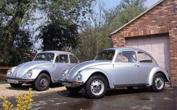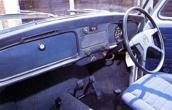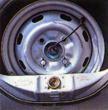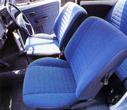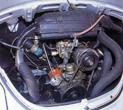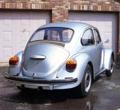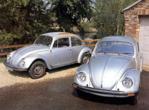
Silver Anniversary (November 2003)
We pity the poor VW historian in years to come. Not next year, maybe, but 20, 30 or perhaps 50 years down the line. Why? Because, in the course of his research, he'll discover that Volkswagen built not one, but two series of 'Last Edition' Beetles! And, if that doesn't confuse him, nothing will.
As far as die-hard Beetle enthusiasts in Europe are concerned, there can only be one true Last Edition Beetle - the title given to the final batch of German-built cars produced to commemorate the end of Beetle production in Germany. But, in 2003, Volkswagen also began referring to the final series of Beetles built in Mexico as 'Last Edition' models. That's why future historians risk being confused...
The cars shown here represent two of the 'proper' Last Edition models, just 300 of which were imported into the United Kingdom in 1978. One is perfect, the other isn't! It is generally accepted that these last cars were all painted Diamond Silver, but this is where things become a little less cut and dried. While there were, indeed, 300 silver Beetles brought into the UK in 1978, Volkswagen (GB) actually imported around 640 Beetles that year - in a variety of colours.
Pedants might argue that all these cars are Last Edition models because they were all built on the same Emden production line, and all represented the end of an era. Some even have later chassis numbers than those sacred 300 cars. True, but it is generally held that only the silver cars were truly worthy of the Last Edition name-tag. They were also the only cars to be sold with a numbered commemorative plaque attached to the dashboard - and this is where further confusion reigns.
You see, each of the 300 silver cars was identified as a Last Edition car by a small, rather unexciting - tacky, if you will - numbered plaque. One would expect the number on each plaque to bear some relation to the chassis number, but that isn't the case. Because a car has a plaque proclaiming it to be, for example, number 198 of the 300, it doesn't follow that it has a chassis number which is higher than a car with the number 150. The distribution of the commemorative plaques seems to have been entirely arbitrary. There appear to be no records, either here or in Germany, which categorically state which plaque was fitted to which car. The finger of suspicion points at the importer, which simply dished out the plaques to dealers for them to fit when the cars were sold: 'Six cars for Colborne's? - OK, give them six plaques. Oops, dropped one. Don't worry, here's another...'. You can see how it might happen.
Each of these final 300 cars was a 1200L Beetle, which means that it was powered by the trusty 34bhp 1192cc engine, which had been in use since 1960 (or 1959, if you take into account the 30bhp version of this 'new' engine, which was briefly used in the Transporter). The only worthwhile differences between the unit used in the Last Edition Beetle and those used in cars built back in the early 1960s were the use of a 55 amp alternator and, of course, 12 volt electrics. Needless to say, nobody bought a 1200L for its performance.
The 'L' suffix - short for 'Lux' - meant that there were certain features which set these cars apart from the run-of-the-mill Beetles produced in former years. The Last Edition 1200Ls came with blue cloth upholstery and a full headlining. There was a padded dashboard, a safety feature first used on the US market back in the 1968 model year, but little else to suggest that this was a 'luxury' car by accepted standards.
The brakes were nothing special, either. Even though disc brakes were commonplace by the end of the 1970s - and had, indeed, been available on certain Beetles since August 1966 - the Last Edition models came equipped with four-wheel drum brakes. This is really indicative of the low esteem in which these cars were held by both the factory and the UK importers. Today, most of what are called 'run-out' models are fitted with just about every possible option to send them off with a bit of a bang, but not the poor old Beetle. It seems once an austere car, always an austere car...
The examples you see before you are as different as chalk and cheese, but have chassis numbers which suggest they were built within hours of each other. Both belong to Matthew 'Buzz' Burrell from Spalding, Lincolnshire, and were purchased from two brothers. One chose to drive the car every day, while his sibling decided to lock his away for a rainy day - or rather, a dry day... In fact, the 'good' car has never - repeat, never - been registered and has covered just 40 miles. As most Volkswagens came with approximately 27 delivery miles on the clock when new, this means that Buzz's 'good' car has covered just 13 miles in the 26 years since it was built in August 1977 - an average of two, yes two, miles per year!
Buzz calls this car 'Mint' and it wears its Last Edition plaque - number 214 - with pride. The chassis number is 118 200 8137 and the engine number D1421464. It has never been recorded on the DVLA computer and still has all the original paperwork from Colborne Garages (which was, incidentally, the very first VW dealer in the UK), showing that it cost just £2428.36.
It is still shod with the original cross-ply tyres and has the original battery and, best of all, three-litres of oil in a shrink-wrapped pack, as supplied by the dealer when the car was first sold! Now that's how you impress the concours judges...
The other car is called, not surprisingly when you look closely, 'Rusty' and has the later chassis number 118 200 8143 (six cars apart) but, conversely, the slightly earlier engine number D1421436. Its plaque shows that it is number 220 of the 300 Diamond Silver celebratory models and has covered some 112,000 miles. Together, the two cars make for a fascinating comparison between a car which has been cosseted and one which has been used (and, probably, abused). Late-model Beetles have never been renowned for their longevity - and 'Rusty' is living proof of that! Both cars are currently for sale as a package ('Buy one, get one free', laughs Buzz), but only to someone who can convince the current owner that 'Mint' will be lovingly cared for and treated with respect. All enquiries will be passed on.
If you are interested in learning more about these last-of-the-line German-built Beetles, you could do no worse (or better, for that matter) than to log on to the website run by the Last Edition Beetle Register at www.lasteditionbeetle.org. Originally set up by Julie Kinley, following the purchase of her own Last Edition Beetle back in 1989, the Register has gone a long way to tracking down the 300 cars sold in the UK.
Sadly, it is known that not all have survived - some were crashed, others rusted into oblivion - but the fate of about half the remaining cars is now known. If you're reading this and own an unrecorded Last Edition Beetle, drop the Register an e-mail at julie@lasteditionbeetle.org, giving details of the chassis and engine numbers, as well as that all-important number on the Last Edition plaque.
Ultra VW November 2003
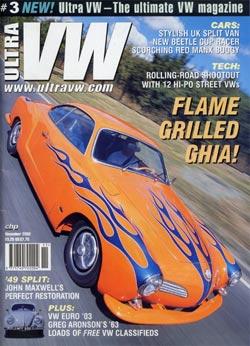
Silver Anniversary
We could just as easily have called this article 'Beauty and the Beast'. Matthew Burrell owns this pair of Last Edition Beetles - one was used regularly, the other wasn't even registered. Words: Keith Seume. Photos:Mike Key.


